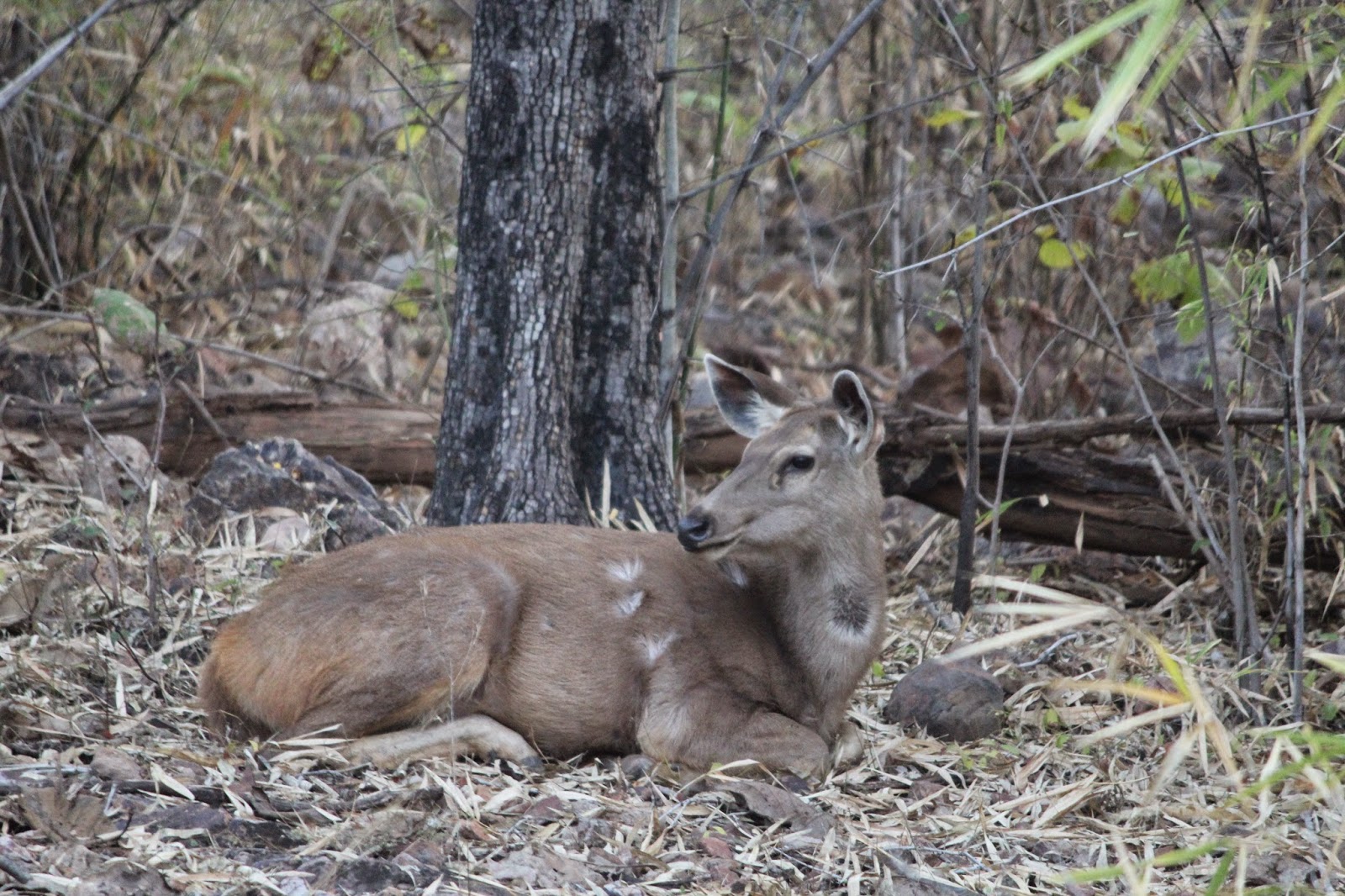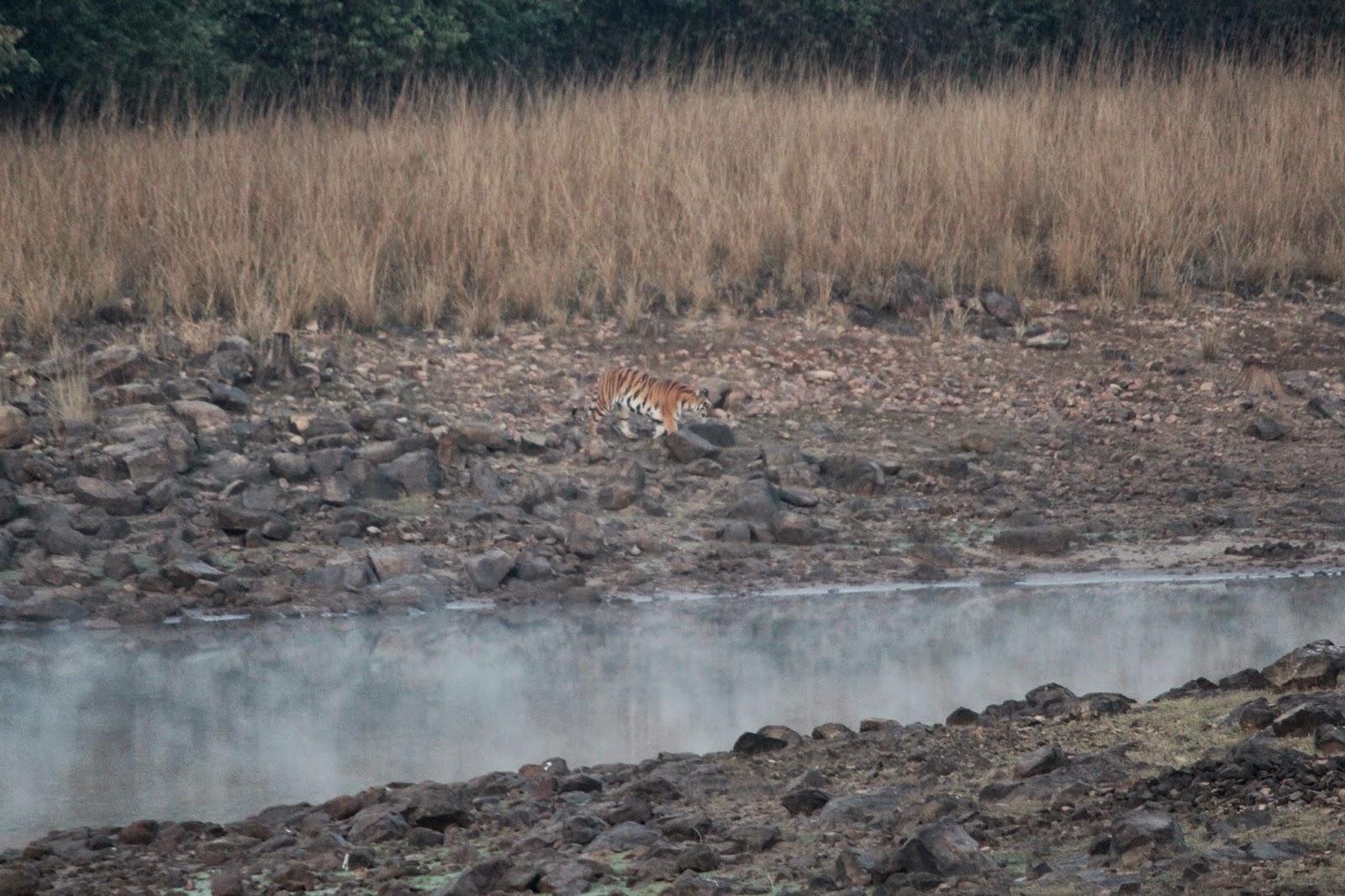“Aapko Dikha?”, “Nahi, dusri gypse wale bata
rahe the unko dikha, aapko dikha kya?”, “nahi hame bhi nahi dikha”
This
is a recurring discussion, happening whenever another 4x4 passes by in the
jungles of Tadoba, as we crisscross the jungle to see the elusive Tiger. This
is our second safari of the three we booked and the only one in the evening.
Freezing cold in the morning makes us believe that the Tiger is not going to
come out of its resting area and this is our only chance to see the Tiger.
Located
30 kms from Chandrapur, and 150 kms from Nagpur, Tadoba – Andhari Tiger reserve
[TATR] is the oldest and largest in Maharashtra and covers an area of roughly
630 square kilometers.
We
decided to spend a weekend in Tadoba and booked three rides from Moharli gate,
which allows a maximum of 30 vehicles per shift and reports maximum sightings out
of 5 gates at Tadoba.
We
reached Tadoba the previous night and stayed at one of the newly set up tented
accommodation – United 21 Tiger Camp.
The beautiful tents with amenities do not help keep the cold away and more so
when the news reaches that Nagpur has recorded the season’s low of 50
C. and Tadoba would be cooler by about 2-3 more degrees. A quick tea, followed
by adding layers of clothes on our body, makes us a little comfortable as we
await dinner in the tented restaurant. Chicken, Dal, Rice, Vegetable, Roti,
Papad and a dessert – we are more than happy to settle for the night with one
thought – will getting up at 4:30AM the next morning be all worth it?
The
rules for arranging the vehicles have changed recently and the hotel manager is
confused. With some calls and asking around, he manages to get two 4x4’s for 6
of us and we quickly settle in to make a 3 kilometer dash to the main Moharli
gate.
It’s
still pitch dark, when we make our way to the forest office to show the ID
cards and the permit – registered online two months ago. We join a long queue
of vehicles – all open 4x4’s as everybody awaits the clock ticking slowly to
hit 6:00AM, when the gates open in winter.
 At
8:30AM, restlessness sinks in, two and half hours in the jungle has yielded
nothing but few common birds, a bunch of monkeys, spotted deer and occasional
sambar. The enthusiasm is wearing out. Our guide painstakingly tells us the
history of this place and explains the various zones, problems of the park and
that occasional state transport bus which still crosses the park to make its
way to district HQ of Chandrapur.
At
8:30AM, restlessness sinks in, two and half hours in the jungle has yielded
nothing but few common birds, a bunch of monkeys, spotted deer and occasional
sambar. The enthusiasm is wearing out. Our guide painstakingly tells us the
history of this place and explains the various zones, problems of the park and
that occasional state transport bus which still crosses the park to make its
way to district HQ of Chandrapur.
At 10:30AM we head back from wherever we are,
disappointed to not have spotted the tiger. On the way back till the gate, the
guides tell us this could be because of the spell of rainfall which the park
witnessed three days ago.
Breakfast
is ready at the hotel when we reach and that is followed by a quick Vegetarian
meal after which the 4x4’s are ready again for the evening safari. In the
second safari, we have seen most of the mammals for the second time, we now
know which route we are going to take and what we will be seeing next. The only
change is an occasional owl or eagle, which we did not spot in the morning.
Heart sinks, when a 4x4 stops and says, “Subah
jate waqt teen gypsy ko tiger dikha, Sonam raasta cross karke jhadi mein gae
hai, kill udhar hai” (Three vehicles saw tigress Sonam this morning, the
tigress crosses the main road and went in the bushes where they suspect she has
killed an animal)
Tigers
are named across National Parks, while Bandhavgarh has had Charget, Sita &
B2, Ranthambore has had Machli. Tadoba, which is home to around 60 tigers as
per our guide, has Sonam, Tara, Maya, Gabbar, Yeda Anna and many more…
Day
two ended with another sumptuous round of food but disappointment about the
tiger. Next day would be our last safari in the jungle, before we head back to
Nagpur. As if it was a routine, the entire family was up and ready at 5:30AM in
the chill – thanks to the hotel being on the banks of reservoir of Erai Dam. The
4x4’s made their way to the gate again, as we did the now familiar process of
identification and waited for the clock to strike 6AM. The guides had a
different plan today, to first show us the Andhari river and then start the
regular circuit with first visiting the Telia lake, followed by other areas.




















As
we entered the Telia lake area, we saw a bunch of vehicles and excited tourists
pointing towards the other bank of the lake. “Udhar hai, pathar ke upar, jhadi ke niche” ( there she is, just above
the stones and below the grassland) was the first intimation that we are
going to see the Tiger. Little straining of eyes and using binocular (10x50)
gives a complete picture of the majestic Tigress- Sonam, resting near the lake.
“arey apne paas dekh rahi hai” (she is
looking at us) says the next voice from another vehicle as the morning calm
is filled with umpteen camera clicks from everybody all around. More 4x4’s join
in and the jostle to find a vantage point leads to the forest department
vehicle ordering all vehicles away.
As
we start moving, Sonam stops to drink water and then crosses the lake from the
shallow area to come over to this bank – only to disappear in dense forest
there on. As irony would have it, the person with longest lens to his camera
has to be helped to see where the Tigress is!
The
day here on is spent in searching for more Tigers around the park, but as the
guide had said on the first day, “chehra
dekh ke hi pata chalta hai, inko tiger dikha ken ahi” – You know if the
person saw the tiger or not by looking at his face. Our faces have lit up as we
criss cross the park yet again. Half an hour before the park closes, we make
another dash to Telia – hoping that Sonam the tigress has decided to roam
around a bit and explore some more area. Back to the hotel, the feeling is of
an successful trip as we pack and make our way to Nagpur !
As
has been the case before, every trip to the jungle ends with a plan of making
another trip to another jungle !
Best Season: For maximum sightings, the best
season is summer – when tigers come near the main roads and sit in the
waterhole which is serviced by tanker. However, summers can be harsh with
temperatures exceeding 45C daily. Weather wise the best season is from February
to April.
Safari: The safari bookings open 60 days in
advance and need to be booked online. The bookings fill up very fast. Maximum vehicles
are allowed from Moharli gate. The park is closed on all Tuesdays. There are
two safari’s a day.
The
permit costs INR 1265 for a maximum of 6 people and the cost of guide and 4x4
is additional which is to be paid before the safari starts. Rules change often,
but currently it was INR 2300 per safari.
Connectivity: Nearest Railhead is Chandrapur
(30kms) on Delhi – Hyderabad / Chennai line and nearest airport is Nagpur
(150kms). The resort can arrange a taxi for pick up. Alternately taxies are
available at Nagpur Airport.
Accommodation: There are ample accommodation
options at Tadoba near all gates. The MTDC property is closer to Moharli gate.
We stayed at United-21 Tiger Camp, an upcoming property, which currently has 20
luxurious swiss tents. The cost was INR 3000 per person per night on twin
sharing inclusive of all meals.
About the authors:
Priyanka Sharangpani - Joshi is a lawyer by profession & a passionate traveler. Priyanka is founding partner at Lex Credence, a law firm based out of Pune. She dreams of visiting all continents in the next 10 years!
Ameya Joshi is a Management professional who dreams of completing atleast one Round the world trip and loves to personally route each trip. His dream destinations Moscow & Istanbul already visited, he now tries saving for a trip to Tahiti.
Both of them are looking for sponsors for a Round the World Trip.











































